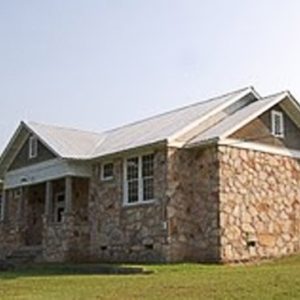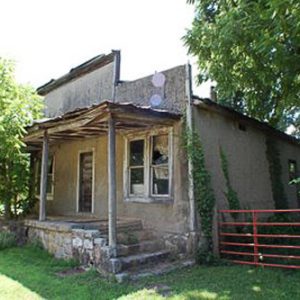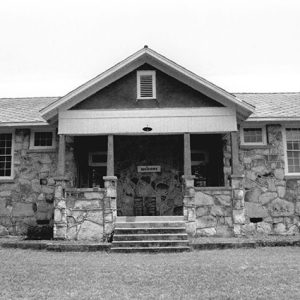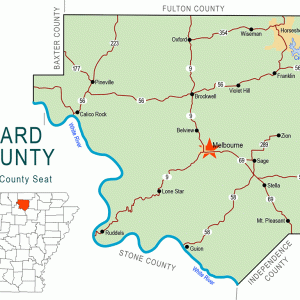calsfoundation@cals.org
Boswell (Izard County)
The unincorporated community of Boswell is located in the White River valley on the western boundary of Izard County. Some of the earliest pioneers to settle there were the Jeffery, Wood, and Langston families. The Langston family arrived at Boswell during Christmas week of 1814. The Jeffery family settled in the Boswell area in 1816, and William Wood settled at Boswell in 1820. The settlers were dependent upon the river as a primary source of transportation, using keelboats and flatboats powered by men using long poles. The early pioneers erected a building that was used as a school as well as a social center. They named this small pioneer community Wideman after the creek that flowed through it. The community grew and spread all the way down Wideman Creek to the White River.
The coming of steamboats made Boswell more accessible. Products and supplies were brought upriver from cities like New Orleans, Louisiana, and Memphis, Tennessee. The farmers’ goods were taken downriver to market. Boswell, like many other river communities, became a growing river port settlement.
The railroad brought an end to the steamboat era. On February 8, 1901, a charter was granted to the White Railway Company to build the White River branch for the St. Louis, Iron Mountain and Southern Railroad Company (which became the Missouri-Pacific Railroad Company in 1917). Also in 1901, a drought resulted in complete crop failures, and the railroad provided employment to the farmers and helped them recover from their losses. The railroads also allowed farmers to ship their products to bigger markets and cattlemen to ship their cattle to stockyards in St. Louis. Area farmsteader Sylvester Smith shipped as many as nine carloads of cattle at one time. Smith also had a contract to supply eggs to the Marion Hotel in Little Rock (Pulaski County), and those were shipped by train. As a result of the railroad’s increasing prominence, the last steamer came upriver in 1906.
On April 5, 1906, a post office was established and named Cook. This caused much confusion, as the train station was named Boswell (after the first station agent, Robert Boswell), while the post office was named Cook and the community Wideman. On September 4, 1915, the community and the post office changed their names to Boswell.
By the 1930s, Boswell was a booming community with an economy based on farming, livestock production, and the railroad industry. The railroad also brought better roads leading to Melbourne (Izard County), and merchants received freight at Boswell and hauled it to Melbourne by wagon.
The old Boswell School building was located on the Vest Spring Branch. In the mid-1930s, a new stone-faced school building was built by the Works Progress Administration (WPA). The building is now owned by the Boswell Baptist Church.
In the 1950s, the Boswell School District was consolidated with the Calico Rock School District. In 1960, the railroad discontinued passenger service and closed the train station. In 2002, the post office was closed. As of the early twenty-first century, the population has dwindled to a very small number.
For additional information:
“Boswell School.” National Register of Historic Places nomination form. On file at Arkansas Historic Preservation Program, Little Rock, Arkansas. Online at http://www.arkansaspreservation.com/historic-properties/_search_nomination_popup.aspx?id=388 (accessed January 24, 2022).
Miller, Mary Cooper. “History of Boswell.” Izard County Historian 12 (July 1981): 13–20.
Phillips, Freda Cruse. Places of our People. Kearney, NE: Morris Publishing, 2011.
Shannon, Karr. A History of Izard County. Little Rock: Democrat Printing Company, 1947.
“Sylvester Smith Farmstead.” National Register of Historic Places nomination form. On file at Arkansas Historic Preservation Program, Little Rock, Arkansas. Online at http://www.arkansaspreservation.com/historic-properties/_search_nomination_popup.aspx?id=387 (accessed January 24, 2022).
David Pittman
History Investigator
 Boswell School
Boswell School  Boswell Store
Boswell Store  Boswell School
Boswell School  Izard County Map
Izard County Map 




Comments
No comments on this entry yet.